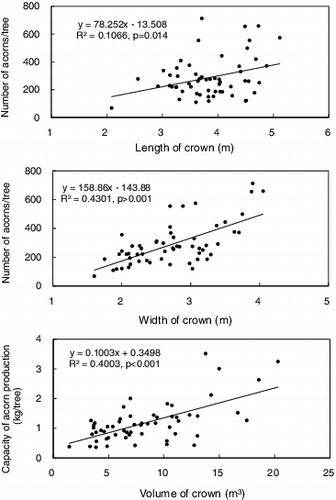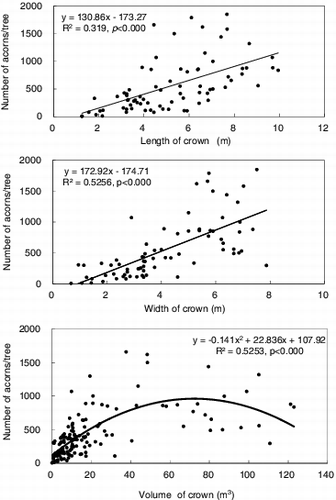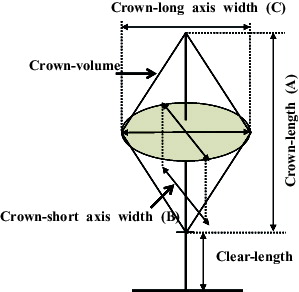Abstract
Acorn production varies considerably among individual trees, years, and locations, which directly affect oak regeneration and populations of wildlife species. This study was conducted to estimate the acorn production capacities of trees in a clonal seed orchard (CSO) of Quercus acutissima by analyzing the relationship among morphological characteristics of acorns, growth characteristics of trees, and the number of acorns per tree in 9-year-old and 15-year-old trees, respectively. The age of the tree did not affect individual acorn morphological characteristics (weight, length, and width), but increased the mean acorn yield per tree from 1.26 kg at 9-year-old to 2.71 kg at 15-year-old. The number of acorns per tree showed strong positive correlations (P < 0.0001) with both crown width and crown volume of the tree. According to our equation, it was estimated that the management of tree density (to 180 trees per ha) and crown volume (to 78 m3) may have the maximum acorn production per ha. Therefore, our results suggested that optimal management of tree density and crown volume may be very effective in increasing the acorn production in CSO of Q. acutissima, which further provides an important initial step in establishing a governmental policy for seedling supply plans.
Introduction
Quercus acutissima is an oak originally native to eastern Asia including Korea, China, and Japan. Q. acutissima mostly grows in sunny places lower than 800 m above sea level (masl), and, along with Q. serrata, has relatively high cold tolerance and volume growth among oak trees (Shin et al. Citation2008; Kim et al. Citation2013). Since the standing volume of Q. acutissima is estimated to be close to 27% of the total forest trees inventory in Korea (Kang et al. Citation2010), it is one of the most economically important tree species in Korea. The tree has been used for forest farming to cultivate shiitake mushroom and Gastrodia elata, as well as for industrial materials such as sawdust, charcoal, and woodchips (Tanaka et al. Citation1995; Fang et al. Citation2011; Park et al. Citation2012). In addition, it is a promising source of bioenergy due to short-rotation coppice culture (Lee et al. Citation2008; Son et al. Citation2004). Acorns are the nuts of oaks and they play an important role in the forest ecosystem since they are a wildlife food resource and seed source for oak regeneration (Darley-Hill and Johnson Citation1981; Kim et al. Citation2002).
Since the late 1950s, the Korean government has been operating clonal seed orchards (CSO) of Q. acutissima with grafted trees of superior phenotypes selected from natural forests and plantations to produce genetically improved acorns (Yim et al. Citation1995; Han et al. Citation1996). The acorn production of oak trees is influenced by age factors as well as tree size (Goodrum et al. Citation1971). Stand density also influences acorn production and thinning increases seed production capacity (Healy Citation1997). Therefore, appropriate tree management is very important to improve acorn production in the seed orchard of oak trees.
Acorn estimation is a prerequisite step in establishing short- and long-term seedling distribution plans. Various techniques have been developed for estimating acorn production (Sork and Bramble Citation1993; Gilland et al. Citation2012; Pourhashemi et al. Citation2013). However, there have been no reports on estimation of acorn production in CSO of Q. acutissima. Most studies on estimation of acorn production have been conducted in forest stands and calculated productivity per unit area by using diameter at breast height (DBH) and crown area (m2) rather than considering the crown characteristics of a tree (Greenberg Citation2000; Rose et al. Citation2012). Thus, an effective prediction of acorn production is needed for the grafted trees in CSO.
This study was carried out to estimate acorn production capacity based on crown characteristics including crown width, crown diameter, and crown volume, as well as to develop a linear regression model to manage appropriate crown volume to enhance the acorn productivity in CSO of Q. acutissima.
Materials and methods
Site description and subject selection
The studied Q. acutissima seed orchard was established in 1999 (99 orchard) and 2005 (05 orchard) by 400 grafts planted with 5 × 5 m spacing and covering 1 ha in Hwaseong, Gyeonggi province, South Korea (37°16′15″ N, 126°55′30″ E). In this study, 75 trees from the 99 orchard and 150 trees from the 05 orchard were randomly selected for examination. Elevation of the CSO is 92 masl to 103 masl. The soil from the CSO had a pH of 5.3, total nitrogen content of 0.38%, a CEC of 6.07 cmolc/kg, average available phosphorus content of 9.25 mg/kg, and an organic matter content of 3.11%.
Acorn sampling and crown characteristics
We investigated the number of acorns from the 05 orchard between July and August each year for 3 years from 2010 to 2012. For the 99 orchard, trees were investigated in August 2012. Acorn characteristics (weight, volume, length, and width) were measured after selecting 60 acorns per clone at random from both the 05 orchard and the 99 orchard, and then dried in the shade. Mean values of acorn volume were obtained after measuring the volume of five acorns per clone using a mass cylinder.
Crown characteristics (tree height, branching height, crown length, crown width, and crown volume) in the CSO were measured using a graduated tree height ruler. Acorn production per tree was estimated as the mean number of acorns per branch of the four sampled branches multiplied by the number of branches per tree (Espelta et al. Citation2009). The crown volume was calculated using a new proposed equation for :
(1) where, A is the crown length, B is the crown short axis width, and C is the crown long axis width.
Data analysis
All experiments were carried out at least in triplicate, and the results were expressed as mean ± standard deviation (SD). Statistical differences among the means were determined by a t-test, while regression analysis was conducted to obtain a coefficient of determination (R2). All statistical procedures were carried out using the SAS program (v9.3; SAS Institute, Cary, NC).
Results and discussion
Acorn production varies substantially according to individual trees, locations, and years, which directly affects forest ecosystem such as oak regeneration and populations of wildlife species (Healy et al. Citation1999). This study was conducted to estimate the acorn production capacities of trees in a CSO of Q. acutissima by analyzing the relationships between morphological characteristics of acorns, growth characteristics of trees, and the number of acorns per tree in 9-year-old and 15-year-old trees, respectively.
Four hundred trees per ha were originally planted in each COS, and about 70% (320/400) and 45% (180/400) grafted trees per ha in the 05 orchard and 99 orchard, respectively, survived at the time of survey.
This survival rate could be explained by competition for light and space among the trees ultimately affecting tree growth. This view is further supported by the finding that high density populations cause a decline in the numbers of surviving plants and a concomitant increase in their mean biomass (White Citation1981).
The mean height of 9-year-old grafted trees in the 05 CSO was about 4.69 m and the mean crown volume was about 8.73 m3. The mean height of 15-year-old grafted trees in 99 CSO was 5.92 m and the mean crown volume was 37.7 m3 (). Analysis of the acorn characteristics including weight, length, and width revealed no significant differences between 9-year-old and 15-year-old trees (). This result indicates that the age of the trees did not affect individual acorn morphological characteristics, with similar results also reported by Long and Jones (Citation1996) who found that acorn weight was generally unrelated to plant size and morphology.
Table 1. Growth characteristics of Quercus acutissima in the clonal seed orchard.
Table 2. Number of acorns per tree, capacity for acorn production, and characteristics of acorns in the clonal seed orchard of Quercus acutissima. The acorn bearing season is from July to August.
On the other hand, differences were observed between the mean weight of acorn production per tree and the grafted age. The mean weight of produced acorns per tree from the 05 CSO was 1.26 kg, while from the 99 CSO it was 2.7 kg. Nonetheless, when it comes to converting these results to possible production capacity per unit area, the 05 CSO could produce a total of 403 kg acorns with 320 trees/ha and the 99 CSO could produce 486 kg with 180 trees/ha. While there was no significant differences between the two groups, the number of acorns per tree in the 05 CSO showed significant positive correlations with crown width (P< 0.001), length (P= 0.014), and volume (P< 0.001) (). The relationship between seed mass and plant size, including height and growth form, has been reported previously (Moles et al. Citation2004). Thomson and Rabinowitz (Citation1989) found a significant correlation between seed mass and plant height within some plant families. Leishman et al. (Citation1995) also reported that plant size is one of the strongest correlates of seed mass. These results show that crown characteristics, including width and volume, in the CSO are very important factors in acorn production capacity.
Figure 2. Relationship between number of acorns and crown characteristics of 9-year-old Quercus acutissima trees in the clonal seed orchard. The dots represent the mean values of the clones (n = 75).

Interestingly, it was observed that as the crown volume of trees increases, the number of acorn bearing trees did not increase accordingly in the 99 CSO (). Rather, after growing to some extent, the number of acorn bearing trees reached its peak and then stopped increasing. Competition for canopy space among trees could be the reason for reducing acorn production (Moles et al. Citation2004; Rees Citation1996). This observation can be expressed through our suggested quadratic regression equation and the formula was more suitable than a simple regression equation, showing a high positive correlation with numbers of acorns per tree in the 99 CSO.
Figure 3. Relationship between number of acorns per tree and crown characteristics of 15-year-old Quercus acutissima in a 99 clonal seed orchard (n = 150).

Based on the regression equation from , the mean crown volume to have the highest yields of acorns per tree was computed to be 78 m3 and the mean acorn number per tree was expected to be a maximum of 1076 acorns. Expected crown width was 7.23 m and the crown length was 9.54 m to produce the maximum of acorns (c. 1076) per tree. Therefore, our results suggested that 180 trees per hectare (7.45 × 7.45 m) with crown volume (to 78 m3) are recommended to yield maximum acorn production per hectare.
This result can explain the fact that appropriate stand management by orchard thinning is needed to provide an opportunity to control tree spacing and maintain/improve crown structure (Healy et al. Citation1999; Devine and Harrington Citation2013). Therefore, our results suggested that optimal management of tree density and crown volume can be very effective in increasing the acorn production in CSO of Q. acutissima, which further provides an important initial step in establishing governmental policy for seedling supply plans.
Disclosure statement
No potential conflict of interest was reported by the authors.
References
- Darley-Hill S, Johnson WC. 1981. Acorn dispersal by blue jay (Cyanocitta cristata). Oecologia. 50:231–232.
- Devine WD, Harrington CA. 2013. Restoration release of overtopped Oregon white oak increases 10-year growth and acorn production. Forest Ecol Manag. 291:87–95.
- Espelta JM, Cortés P, Molowny-Horas R, Retana J. 2009. Acorn crop size and pre-dispersal predation determine inter-specific differences in the recruitment of co-occurring oaks. Oecologia. 161:559–568.
- Fang S, Liu Z., Cao Y, Liu D, Yu M, Tang L. 2011. Sprout development, biomass accumulation and fuelwood characteristics from coppiced plantations of Quercus acutissima. Biomass Bioenerg. 35:3104–3114.
- Gilland KE, Keiffer CH, McCarthy BC. 2012. Seed production of mature forest-grown American chestnut (Castanea dentata (Marsh.) Borkh). J Torrey Bot Soc. 139:283–289.
- Goodrum PD, Reid VH, Boyd JC. 1971. Acorn yields, characteristics, and management criteria of oaks for wildlife. J Wildl Manage. 35:520–532.
- Greenberg CH. 2000. Individual variation in acorn production by five species of southern Appalachian oaks. Forest Ecol Manag. 132:199–210.
- Han YC, Chung HG, Min YT, Kang KS. 1996. Plus tree handbook. Republic of Korea: Forest Genetics Research Institute; p. 180–195.
- Healy WM. 1997. Thinning New England oak stands to enhance acorn production. North J Appl For. 14:152–156.
- Healy WM, Lewis AM, Boose EF. 1999. Variation of red oak acorn production. Forest Ecol Manag. 116:1–11.
- Kang KS, Kim CS, El-Kassaby YA. 2010. Clonal variation in acorn production and its effect on the effective population size in a Quercus acutissima seed orchard. Silvae Genet. 59:170–175.
- Kim HE, Koo CD, Kim JS, Park JI, Shin WS, Shin CS. 2002. Ecological characteristics of below-ground ectomycorrhizal colony of Sarcodon aspratus in oak tree stands. J Korean For Soc. 91:457–464.
- Kim TU, Sung JH, Kwon TS, Chun JH, Shin MY. 2013. Assessment of productive areas for Quercus acutissima by ecoprovince in Korea using environmental factors. J Korean For Soc. 102:437–445.
- Lee SH, Eoma MS, Yoo KS, Kim NC, Jeon JK, Park YK. 2008. The yields and composition of bio-oil produced from Quercus acutissima in a bubbling fluidized bed pyrolyzer. J Anal Appl Pyrol. 83:110–114.
- Leishman MR, Westoby M, Jurado E. 1995. Correlates of seed size variation: a comparison among five temperate floras. Journal of Ecology. 83:517–529.
- Long TJ, Jones RH. 1996. Seedling growth strategies and seed size effects in fourteen oak species native to different soil moisture habitats. Trees. 11:1–8.
- Moles AT, Falster DS, Leishman MR, Westoby M. 2004. Small-seeded species produce more seeds per square metre of canopy per year, but not per individual per lifetime. Journal of Ecology. 92:372–383.
- Park EJ, Lee WY, Ahn JK. 2012. In vitro propagation of myco-heterotrophic Gastrodia elata. Hortic Environ Biotechnol. 53:415–420.
- Pourhashemi M, Panahi P, Zandebasiri M. 2013. Application of visual surveys to estimate acorn production of Brant's oak (Quercus brantii Lindl.) in northern Zagros Forests of Iran. Caspian J Env Sci. 11:85–95.
- Rees M. 1996. Evolutionary ecology of seed dormancy and seed size. Phil Trans R Soc Lond B Biol Sci. 351:1299–1308.
- Rose AK, Greeberg CH, Fearer TM. 2012. Acorn production prediction models for five common oak species of the Eastern United States. J Wildl Manage. 76:750–758.
- Shin MY, Kim SH, Jeong JH, Kim CC, Jeon EJ. 2008. Development of volume growth rate model for major Quercus species in Korea. J Korean For Soc. 97:627–633.
- Son Y, Park IH, Yi MJ, Jin HO, Kim DY, Kim RH. 2004. Biomass, production and nutrient distribution of a natural oak forest in central Korea. Ecol Res. 19:21–28.
- Sork VL, Bramble JE. 1993. Prediction of acorn crops in three species of North American oaks: Quercus alba, Q. rubra and Q. velutina. Ann Sci For. 50:128s–136s.
- Tanaka N, Shimumura K, Ishimaru K. 1995. Tannin production in callus cultures of Quercus acutissima. Phytochemistry. 40:1151–1154.
- Thompson K, Rabinowitz D. 1989. Do big plants have big seeds? Am Nat. 133:722–728.
- White J. 1981. The allometric interpretation of the self-thinning rule. Theor Biol. 89:475–500.
- Yim KB, Min YT, Kim YM, Han SD, Kwon HM. 1995. Oak trees. Republic of Korea: Institute of Forest Genetics; p. 35–52.

